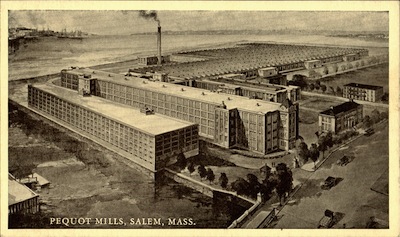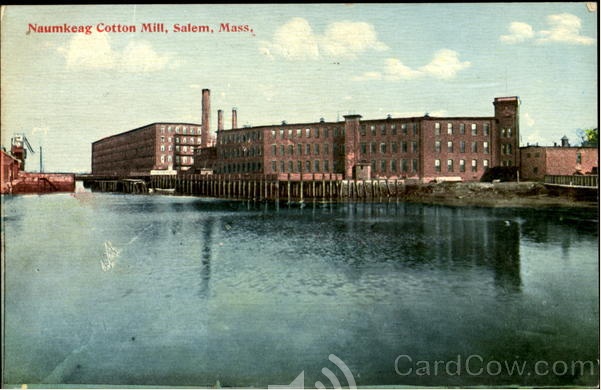Pequot Mills: Difference between revisions
From Salem Links and Lore
No edit summary |
No edit summary |
||
| (14 intermediate revisions by the same user not shown) | |||
| Line 1: | Line 1: | ||
*Pequot Mills was owned and operated by Naumkeag Steam Cotton | *Pequot Mills was owned and operated by [[Naumkeag Steam Cotton Company]] from 1847 until its closing in 1953. They made sheets and pillowcases under the brand name Pequot. | ||
*Former sea captain, Nathaniel Griffin began organizing a Salem cotton mill in the late 1830's. The site chosen for the mill was Stage Point, just opposite the South River Channel from what is today Pickering Wharf. The location was accessible to ships that would transport the cotton from the south, and because it was sea level, it offered the right level of humidity needed for separating cotton fibers. | *Former sea captain, Nathaniel Griffin began organizing a Salem cotton mill in the late 1830's. The site chosen for the mill was Stage Point, just opposite the South River Channel from what is today Pickering Wharf. The location was accessible to ships that would transport the cotton from the south, and because it was sea level, it offered the right level of humidity needed for separating cotton fibers. | ||
*The Salem plant was one of the first steam-operated cotton mills in the country. The facility was built at a cost of just over $621,000 and initially employed 600 workers. During World War II it grew to 2,725 workers. In 1909, the firm acquired the Danvers Bleachery (located in Peabody). | *The Salem plant was one of the first steam-operated cotton mills in the country. The facility was built at a cost of just over $621,000 and initially employed 600 workers. During World War II it grew to 2,725 workers. In 1909, the firm acquired the Danvers Bleachery (located in Peabody). | ||
*During the great Salem fire of June 25, 1914, all but two small buildings of the mills burned to the ground. The company rebuilt, making the new plant powered by electricity. | *During the great Salem fire of June 25, 1914, all but two small buildings of the mills burned to the ground. The company rebuilt, making the new plant powered by electricity. | ||
*In 1933, there was a violent eight week strike when hundreds of workers went on strike against the company and their own union, a local branch of the United Textile Workers of America. | *In 1933, there was a violent eight week strike when hundreds of workers went on strike against the company and their own union, a local branch of the United Textile Workers of America. | ||
*Among the immigrant groups to work at the mills were: French-Canadians, | *The 1933 strike was finally resolved when President Franklin D. Roosevelt sent mediators to reach a consensus between the striking workers and the employers. | ||
*Among the immigrant groups to work at the mills were: French-Canadians, Polish, Italians and Russians. | |||
*Pequot Mills closed late in 1953, and moved operations to Whitney, South Carolina after merging with Indian Head Mill. More than 800 people lost their jobs. The buildings in the area are now called [[Shetland Park]]. | *Pequot Mills closed late in 1953, and moved operations to Whitney, South Carolina after merging with Indian Head Mill. More than 800 people lost their jobs. The buildings in the area are now called [[Shetland Park]]. | ||
*For photographs of children working in the factories from the Lewis Hine photography collection, see wiki entry [[Lewis Hine Photographs]] | *For photographs of children working in the factories from the Lewis Hine photography collection, see wiki entry [[Lewis Hine Photographs]] | ||
| Line 14: | Line 15: | ||
[[Category:Businesses]] | [[Category:Businesses]] | ||
==See Also== | ==See Also== | ||
*Postcards Image courtesy of CardCow.com | *Postcards Image courtesy of '''CardCow.com''' | ||
*"Rise and fall of a cotton mill" ''Salem Evening News'', Mar.8, 2000, p.A2 | *"Rise and fall of a cotton mill" ''Salem Evening News'', Mar.8, 2000, p.A2 | ||
*[http:// | |||
*[http:// | *[http://evergreen.noblenet.org/eg/opac/record/2051560?locg=63 Story of Pequot] by C. Jarvis | ||
*[ | |||
*[http://evergreen.noblenet.org/eg/opac/record/2051423?locg=63 The Pequot Story] by Naumkeag Steam Cotton Co., 1949. | |||
*[https://www.flickr.com/photos/salemstatearchives/albums/72157704504064565 Naumkeag Steam Company/Pequot Mills] Salem State Archives (photos) | |||
*Vertical File in Salem Collection - '''Pequot Mills''' | *Vertical File in Salem Collection - '''Pequot Mills''' | ||
*"City Officials in attempt to keep Naumkeag Mills" ''Salem Evening News'', Aug. 14, 1953, p.1 | *"City Officials in attempt to keep Naumkeag Mills" ''Salem Evening News'', Aug. 14, 1953, p.1 | ||
*[http:// | |||
*[http://evergreen.noblenet.org/eg/opac/record/2622792?locg=1 Linked labor histories : New England, Colombia, and the making of a global working class] A. Chomsky | |||
*[http://evergreen.noblenet.org/eg/opac/record/2243932?locg=63 Salem : place, myth, and memory] ed. by D. Morrison, N. Schultz (p. 222-225) | |||
*[http://evergreen.noblenet.org/eg/opac/record/2264429?locg=63 Architecture in Salem] by Tolles, p. 232 | |||
*[http://evergreen.noblenet.org/eg/opac/record/1352984?locg=1 Sketches about Salem People] Article: Stage Point and thereabouts by J. Foster Smith | |||
Latest revision as of 13:12, 29 February 2024
- Pequot Mills was owned and operated by Naumkeag Steam Cotton Company from 1847 until its closing in 1953. They made sheets and pillowcases under the brand name Pequot.
- Former sea captain, Nathaniel Griffin began organizing a Salem cotton mill in the late 1830's. The site chosen for the mill was Stage Point, just opposite the South River Channel from what is today Pickering Wharf. The location was accessible to ships that would transport the cotton from the south, and because it was sea level, it offered the right level of humidity needed for separating cotton fibers.
- The Salem plant was one of the first steam-operated cotton mills in the country. The facility was built at a cost of just over $621,000 and initially employed 600 workers. During World War II it grew to 2,725 workers. In 1909, the firm acquired the Danvers Bleachery (located in Peabody).
- During the great Salem fire of June 25, 1914, all but two small buildings of the mills burned to the ground. The company rebuilt, making the new plant powered by electricity.
- In 1933, there was a violent eight week strike when hundreds of workers went on strike against the company and their own union, a local branch of the United Textile Workers of America.
- The 1933 strike was finally resolved when President Franklin D. Roosevelt sent mediators to reach a consensus between the striking workers and the employers.
- Among the immigrant groups to work at the mills were: French-Canadians, Polish, Italians and Russians.
- Pequot Mills closed late in 1953, and moved operations to Whitney, South Carolina after merging with Indian Head Mill. More than 800 people lost their jobs. The buildings in the area are now called Shetland Park.
- For photographs of children working in the factories from the Lewis Hine photography collection, see wiki entry Lewis Hine Photographs
See Also
- Postcards Image courtesy of CardCow.com
- "Rise and fall of a cotton mill" Salem Evening News, Mar.8, 2000, p.A2
- Story of Pequot by C. Jarvis
- The Pequot Story by Naumkeag Steam Cotton Co., 1949.
- Naumkeag Steam Company/Pequot Mills Salem State Archives (photos)
- Vertical File in Salem Collection - Pequot Mills
- "City Officials in attempt to keep Naumkeag Mills" Salem Evening News, Aug. 14, 1953, p.1
- Salem : place, myth, and memory ed. by D. Morrison, N. Schultz (p. 222-225)
- Architecture in Salem by Tolles, p. 232
- Sketches about Salem People Article: Stage Point and thereabouts by J. Foster Smith


